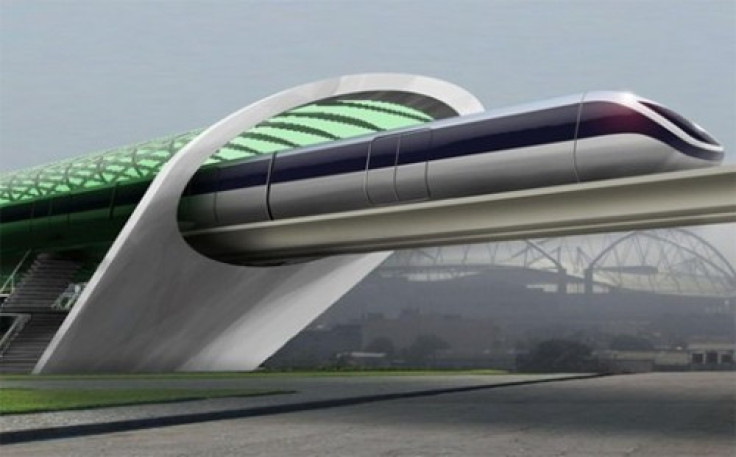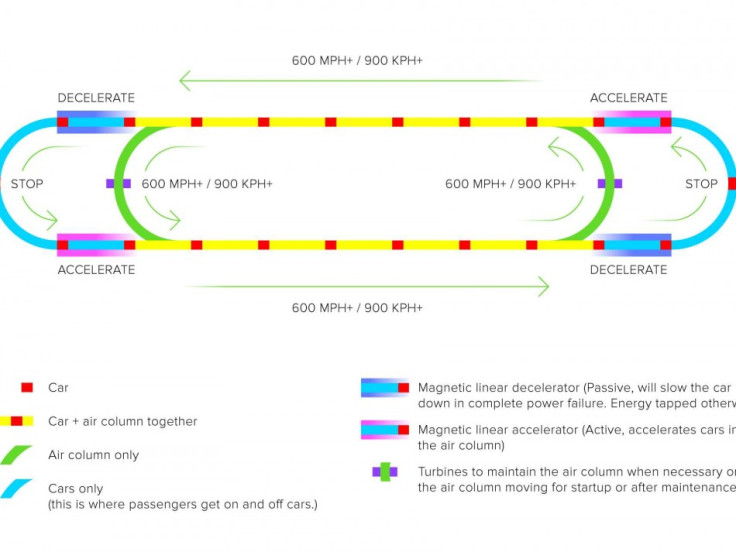Elon Musk and Hyperloop: How 600mph San Francisco to Los Angeles Public Transport Could Work
Paypal founder Elon Musk is set to reveal all about Hyperloop in ten days time, here Alistair Charlton looks at how it could work.

By 12 August, Tesla founder Elon Musk will have announced plans for a new form of transportation which will take passengers 300 miles from San Francisco to Los Angeles in half an hour.
Such a claim would usually be swatted away as impossible, but Musk has a habit of proving critics wrong, having revolutionised internet banking with Paypal, made the electric car a success with Tesla and proved that reusable rockets are a solution to keep the space race alive with SpaceX. This is also a man who wants to retire with a one-way ticket to Mars.
Musk is setting out to prove the US government is wrong with its proposal to construct a high speed railway on the same San Francisco-to-Los Angeles route at a cost of more than $60 billion (£40bn); Musk reckons he can build a faster, safer and more efficient system for a tenth of that amount.
Will publish Hyperloop alpha design by Aug 12. Critical feedback for improvements would be much appreciated.
Elon Musk (@elonmusk) July 15, 2013
Called Hyperloop, Musk described his futuristic transportation system last year as "a cross between a Concorde and a railgun and an air hockey table," while noting that it had no need for rails, will never crash, is immune to the weather, and would cost passengers less than buying a plane ticket or making the 300-mile journey by car. Musk also believes Hyperloop can be self-sufficient, generating more than enough energy to power itself from attached solar panels.
Speculation
With such bold claims it didn't take long for speculation to mount as to what Hyperloop was and if travelling 300 miles in 30 minutes is even remotely possible - especially on such a small budget. The most widely-publicised theory is from John Gardi and is a tunnel running in a continuous loop from one city to the other and back again. Inside the tunnel there would be a constant flow of air traveling at 600mph in the same direction as the train.

A 600mph tailwind chasing a 600mph train would result in near-zero relative drag, but blasting air at almost 80% of the speed of sound for hundreds of miles would require huge amounts of power, and the noise would be immense. Critics of Gardi's plan also say air turbulence and drag will still occur, but against the walls of the tunnel instead of the vehicle itself, slowing it down. Despite this, Musk tweeted to say Gardi's plan "is the closest I've seen anyone guess so far".
@John_Gardi your guess is the closest I've seen anyone guess so far. Pod diameter probably around 2m Elon Musk (@elonmusk) July 15, 2013
Alternatively, an hermetically-sealed tunnel containing no air at all would give the potential for near-limitless speed, as removing air removes drag, and drag is the main reason why Japan's latest bullet train can go no faster than 311mph. As speed builds, the force of air pressing down on a vehicle is squared, so eventually huge increases in power are required for a very small gain in top speed.
Apart from the energy required to create either a vacuum or a 300-mile tunnel filled with 600mph air, both theories have potential for major accidents if either were to fail, or the tunnel wall were breached; adding to the confusion. Musk has said that Hyperloop cannot crash and is not a vacuum.
Not a train
The most recent suggestion comes from Electric Takeoff, a group of engineers, pilots and entrepreneurs developing a new form of electric transport for aviation and space launches.

In a post on 2 August a member of Electric Takeoff known as John C, proposes a solution for Hyperloop, and constructs the most innovative theory yet - Hyperloop is not a train.
John acknowledges that a system of tunnels and trains could be built for $6bn, but challenges Musk's ability to buy the land and secure planning and right-of-way permission for the 300-mile route.
"Permitting and land access will be big problems for a ground-based system," he writes. "Electric aviation is going to be more viable than a system requiring a right-of-way between LA and San Francisco.
"I predict Hyperloop will be a pair of launch tubes that accelerate electric aircraft up to 600mph using electromagnetic propulsion. The aircraft would exit the launch tube and fly with battery power to the destination [then] make a powered vertical landing with electric ducted fans."
Vertical landing has already been successfully developed by Musk's SpaceX company to land a reusable rocket called Grasshopper. Although it is doubful that Musk will incoporate rockets with electric public transport, SpaceX's research into vertical landing could still lend itself to Hyperloop.
Weather fluctuations
Musk has previously explained how electric planes can fly higher than conventional aircraft and has expressed an interest in developing one. Hyperloop could fly at more than 70,000 feet, much higher than commercial jets at 36,000ft and even Concorde, which flew at 60,000ft, making Musk's system all but immune to weather fluctuations as promised.
As for achieving an average speed of 600mph, the current record for an electric plane stands at just over 200mph, so Musk has his work cut out if he is to develop an aircraft capable of travelling three times faster.
And there's another sticking point - the post on Electric Takeoff mentions transferable battery packs stored in the aircraft and charged by solar power at each terminal, but Musk claimed last year that "there's a way to store power so it would run 24/7 without batteries".
Ten years on from the premature withdrawal of Concorde from commercial flights, the world has learnt to cope without time zone-beating transport, preferring cheap mass transit and holding transatlantic meetings online instead.
But if Musk can produce a means of transport capable of almost half the speed of Concorde and with significantly cheaper fares, then the 42-year-old could be light years ahead of the competition.
© Copyright IBTimes 2024. All rights reserved.






